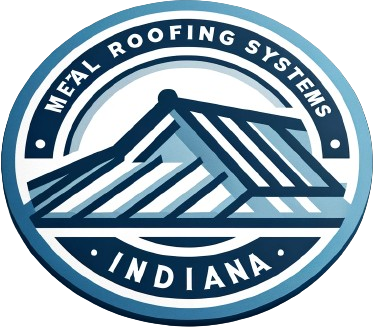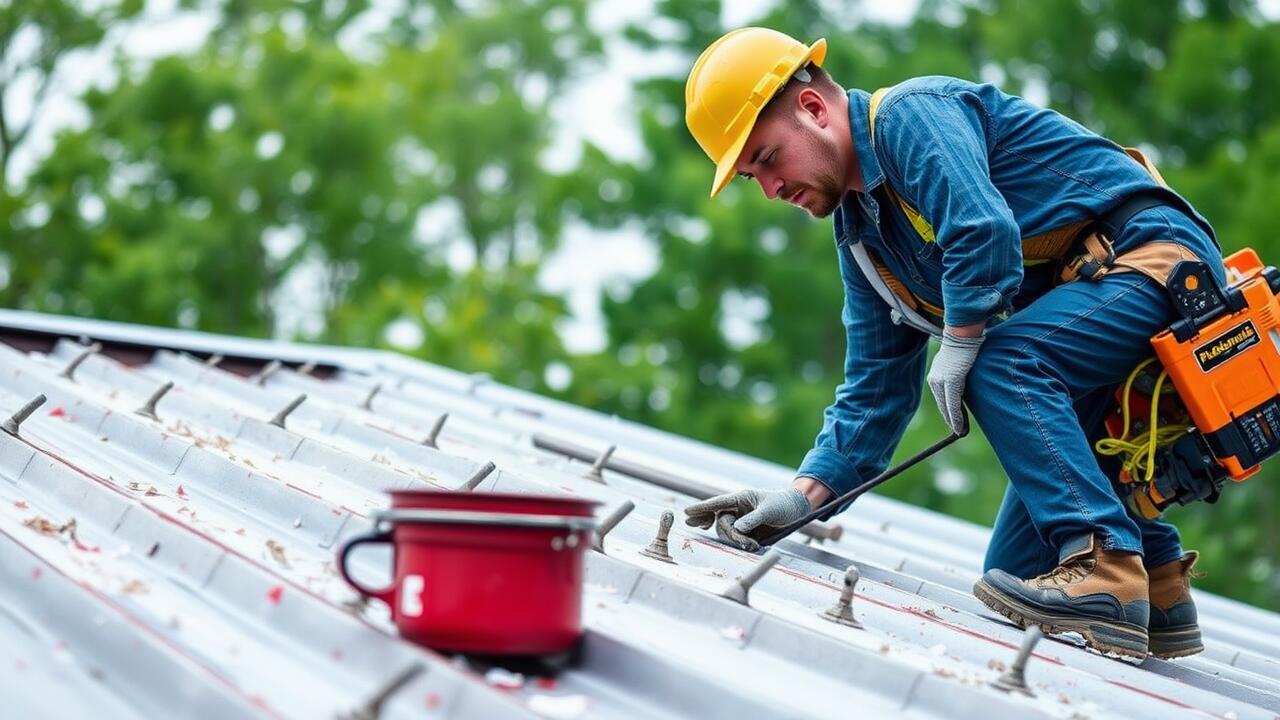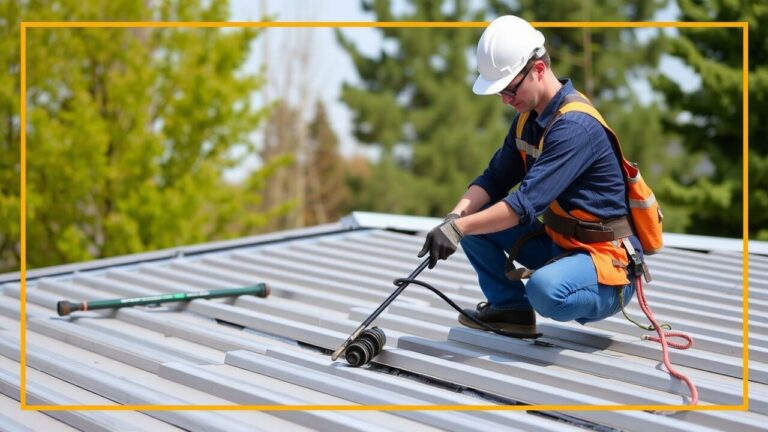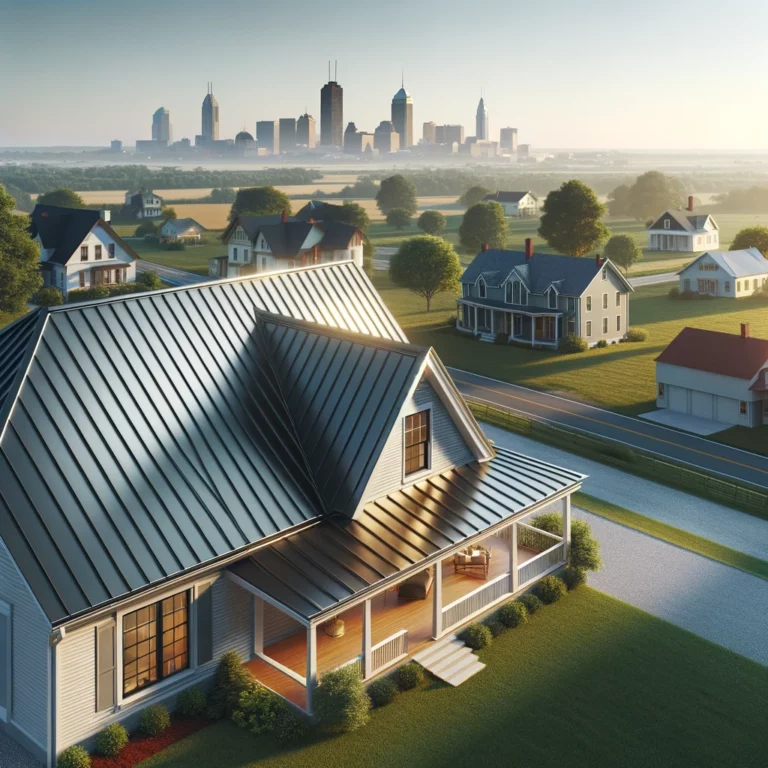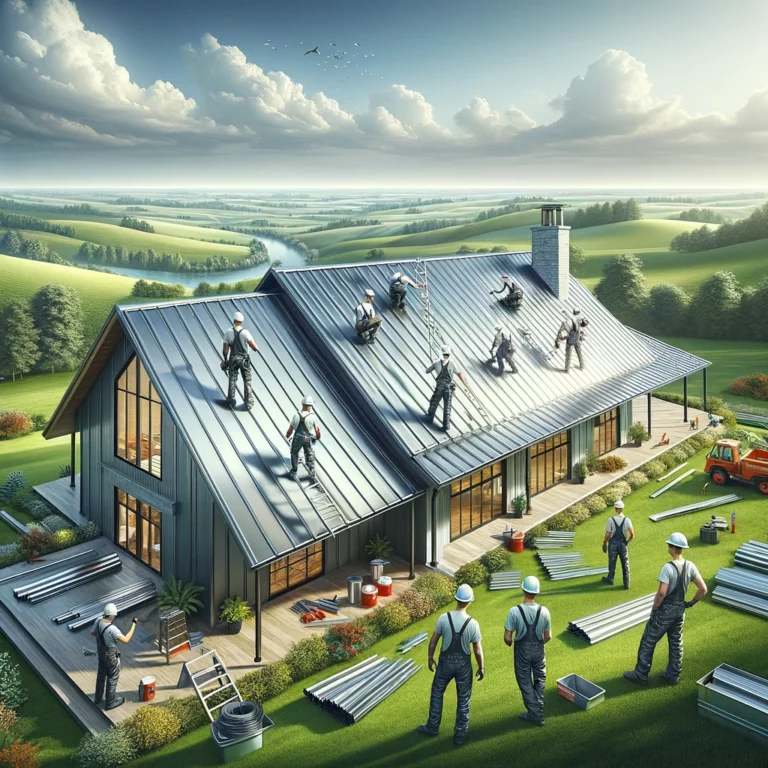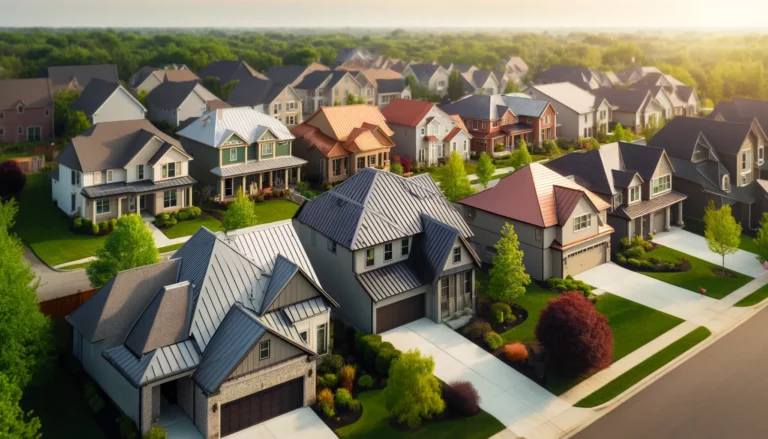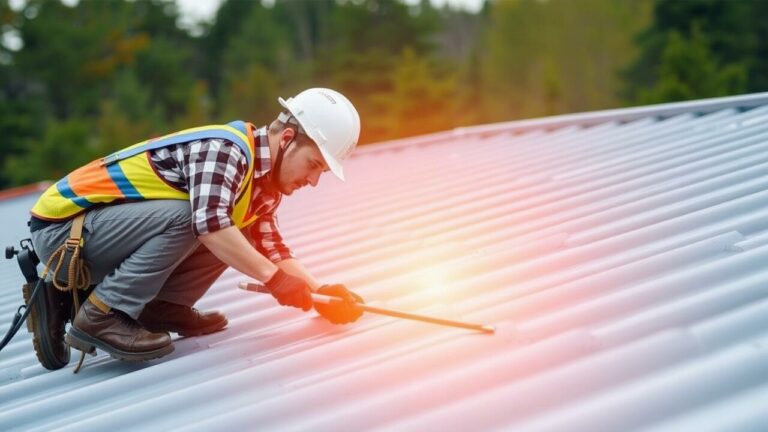How Metal Roofs Withstand Indiana’s Harsh Weather Conditions
Metal roofs, oh, they’re a game changer when it comes to energy efficiency—especially in Indiana, where the weather can swing wildly from scorching heatwaves to frigid chills. These marvels of modern engineering boast reflective properties that work wonders in summer. By bouncing sunlight away, they keep indoor spaces cooler than a cucumber, which means less dependency on air conditioning. And you know what that translates into? Lower energy bills—a sweet deal for any homeowner.
But wait! There’s more! Metal roofs aren’t just about reflecting light; they also excel at insulation. When paired with the right insulation materials, these roofs create an impressive barrier against those biting winter winds and sneaky drafts. This dual action not only heightens the coziness of your home but also slashes heating costs during those icy months. Homeowners are discovering that investing in metal roofing systems isn’t just smart—it’s practically a no-brainer for anyone navigating Indiana’s unpredictable climate shifts and looking to save some green over time.
Reflectivity and Insulation of Metal Roofs
Metal roofs are crafted with a keen focus on maximizing energy efficiency, and they do so in a rather fascinating way—by reflecting sunlight. This remarkable reflective quality slashes heat absorption during those sweltering summer months, ultimately leading to lower cooling costs while simultaneously enhancing the coziness of indoor spaces. Imagine this: high solar reflectance is particularly advantageous in areas that sizzle under extreme heat—it’s like having an air conditioner built right into your roof! It works tirelessly to keep temperatures stable within homes and buildings. What’s more, numerous metal roofing options flaunt an Energy Star certification, proudly highlighting their prowess in curbing heat accumulation.
But wait, there’s more! Beyond just reflectivity lies another treasure trove of benefits: insulation galore! When paired with the right underlayment and ventilation strategy, metal roofs form a formidable thermal barrier that significantly cuts down on heat loss throughout the frigid winter months. With proper insulation wrapped around your home like a warm blanket, you’ll find comfort levels soaring while your dependence on heating systems plummets—resulting in delightful savings on those pesky energy bills. So homeowners can revel in not just reduced energy consumption but also an uptick in everyday comfort by opting for metal roofing infused with these insulating virtues.
| Property | Metal Roof Benefit | Impact on Energy Efficiency |
|---|---|---|
| Reflectivity | Reduces heat absorption | Lowers cooling costs in summer |
| Insulation | Forms a thermal barrier | Minimizes heat loss in winter |
| Energy Star Certification | Indicates high solar reflectance | Promotes energy efficiency standards |
| Underlayment and Ventilation | Enhances insulation effectiveness | Improves overall comfort and reduces heating needs |
Maintenance Requirements
Routine inspections—oh, they’re not just a good idea; they are the lifeblood of metal roofing systems! Homeowners, listen up: you should be peering at your roof with keen eyes at least twice a year! Focus particularly on those sneaky spots where debris loves to gather—think valleys and gutters. Clear out any pesky obstructions that might cause water to pool like an unwanted guest because standing water is a recipe for corrosion or leakage disaster.
But don’t stop there; let’s talk fasteners! These little heroes deserve regular attention too. As temperatures dance between extremes, thermal expansion and contraction can loosen their grip over time—so make sure they’re still holding strong!
Now, onto cleaning—a straightforward regimen here can really stretch the lifespan of your metal roof. Give it a good hosing down to wash away dirt, leaves, and other unwelcome visitors. This simple act doesn’t just keep things looking spiffy but also wards off potential harm lurking beneath that grime. For deeper cleans? A gentle scrub with mild detergent mixed in some warm water works wonders—but steer clear from harsh chemicals that could ruin the precious finish!
And while you’re up there (safely!), don’t forget to check on the paint and finish like a vigilant guardian—you’ll catch any areas needing touch-ups before they become more significant issues. In doing so, you preserve not only the integrity of your beloved roof but its overall aesthetic charm as well!
Long-Term Care for Metal Roofing Systems
Caring for metal roofing systems over the long haul isn’t just a good idea; it’s essential if you want to keep them durable and efficient throughout their lifespan. Picture this: regular inspections, like twice a year or right after those wild storms, are your first line of defense against wear, corrosion, and damage lurking in the shadows. You can’t ignore the roof’s cleanliness—clearing away debris and hunting down pesky moss or algae is crucial for maintaining its integrity.
But wait! There’s more to maintenance than just keeping it tidy. Those surface blemishes? They need attention—nip them in the bud before they transform into rust formations that could wreak havoc on your roof. Think about applying protective coatings; not only do they jazz up appearances but also extend longevity like an old friend who never ages. And let’s not forget about those spots where metal panels overlap—watch out! They’re often leak-prone little troublemakers that demand close monitoring.
Oh, and don’t overlook loose fasteners! A simple tightening can bolster your roof’s overall stability significantly. It’s all about being proactive here; these measures help preserve your roof’s condition while potentially saving you from sinking money into costly repairs or replacements later on down the road. So gear up for some thoughtful upkeep—it pays off big time!
Installation Process
The dance of installing metal roofing unfolds in a series of pivotal steps, each one crucial for ensuring that the final result stands strong against the test of time. First up? The groundwork—a meticulous inspection of the underlying structure to identify and rectify any lurking issues before they become headaches down the road. Depending on what type of metal roof you’re working with, layering in extra underlayment can be a game-changer for waterproofing prowess.
Now, let’s talk materials and fasteners—oh boy! In Indiana’s unpredictable weather tapestry, choosing wisely here is paramount; these elements play a starring role in how well your roof performs over its lifespan.
With preparation wrapped up like a present ready to be unwrapped, it’s go-time for installation. Precision is key—every measurement demands attention as each panel finds its rightful place. Misalignment could spell leaks or compromise structural integrity; nobody wants that mess! Timing matters too; tackling this project during temperate weather helps sidestep those pesky expansion and contraction dramas.
Ventilation comes into play again—it’s not just about keeping cool air flowing but also extending your roof’s life by managing temperature swings effectively. Following best practices during installation doesn’t merely boost performance; it firmly aligns with manufacturer guidelines to keep warranties intact—a win-win situation! So roll up those sleeves: every step counts in crafting an enduring shield overhead!
Best Practices for Metal Roof Installation
Before the installation kicks off, getting the existing roof surface prepped to perfection is non-negotiable. Think of it as laying the groundwork for what’s to come—any hidden damage needs mending, and a solid structure is a must. Enter quality underlayment material: this unsung hero not only acts as a moisture barrier but also cranks up insulation levels significantly. Plus, adhering meticulously to manufacturer specifications ensures that panels are trimmed and cut with surgical precision, sparing you from headaches down the line.
Now, here’s where things get interesting: selecting an experienced contractor who knows their way around metal roofing systems isn’t just important—it’s vital! It’s all in the details; flawless flashing, impeccable seam sealing, and spot-on fastener placement can make or break your roof’s lifespan. And don’t forget about those local building codes—their ever-shifting nature can have profound impacts on both installation techniques and materials used. By embracing these best practices wholeheartedly, you’ll end up with a robust metal roof ready to brave Indiana’s unpredictable weather like a champ!
Cost-Effectiveness Over Time
Diving into the world of metal roofing can unveil a treasure trove of long-term savings, especially in areas battered by fierce weather. Imagine this: the sheer durability and steadfast resilience of metal roofs mean fewer repairs—both in frequency and cost—as time wends its way forward. In stark contrast, traditional roofing materials often demand replacement or hefty maintenance after just a handful of years. But here’s the kicker—metal roofs typically boast warranties that stretch up to 50 years! That’s not merely a promise; it’s a testament to their longevity and reliability.
But wait, there’s more! The energy efficiency factor kicks in too, adding another layer to the financial allure of metal roofs. With their superb reflectivity, these systems keep indoor spaces cozy while potentially slashing those energy bills for both heating and cooling needs. Plus, who wouldn’t want to snag some tax credits or rebates tied to energy-efficient home upgrades? All told, that initial outlay for installing metal roofing doesn’t just evaporate—it transforms into substantial long-term savings, making it an undeniably smart financial move for homeowners looking ahead.
Comparing Metal Roofing to Traditional Materials
When it comes to selecting roofing materials, a fascinating contrast emerges between the sleek allure of metal options and the more conventional choices like asphalt shingles or wood shakes. Metal roofs—oh, they’re not just pretty faces! They’re champions of durability, boasting lifespans that can eclipse those of standard roofing materials by leaps and bounds. While your typical asphalt roof might cling to life for a mere 15 to 30 years, those robust metal systems? They often thrive for 50 years or even longer with just a touch of maintenance here and there. It’s almost as if they’re winking at you from the rooftop—a wise investment that hints at fewer headaches down the road in terms of replacements and repairs.
But let’s dive deeper into another critical factor: how these materials hold up against Indiana’s wild weather whims. Picture this: metal roofs are engineered to deftly shed snow and rain, an elegant dance that significantly reduces leak risks and water damage woes. In stark contrast, traditional materials can be susceptible—vulnerable might be too gentle a word—to rot, mold growths lurking in shadows, and wind damage battering their integrity. The resilience of metal roofing stands tall amidst ferocious storms; it means homeowners can breathe easier knowing they’re less likely to face nasty surprises when Mother Nature throws her tantrums. Ultimately, this capability enhances long-term reliability—and oh boy!—the sweet peace of mind that comes with it is simply priceless for any homeowner looking skyward.
Environmental Impact
The allure of metal roofing options lies in their remarkable sustainability, shimmering with recyclability and energy efficiency. Picture this: many of these roofs are crafted from recycled materials, a fact that dramatically slashes the environmental footprint tied to production. But wait—there’s more! Their impressive longevity means fewer replacements over time, which translates into less waste piling up in landfills. It’s as if each sturdy roof contributes to an eco-friendly symphony, enhancing the overall life cycle assessment and spotlighting its vital role in curbing environmental impact.
But that’s not all! Metal roofs also play a significant part in energy conservation. Thanks to their reflective properties, they work wonders by reducing heat absorption—hello lower energy bills during those sweltering summer months! By keeping heat at bay, these roofs diminish our dependence on air conditioning systems—a double win for both your wallet and Mother Earth. In states like Indiana where temperature swings are the norm, the energy-saving magic of metal roofs takes center stage, becoming essential allies in fostering a greener building landscape.
Sustainability Aspects of Metal Roofing Options
Metal roofing systems present a fascinating tapestry of sustainability benefits, intricately woven into the fabric of our modern environmental ethos. Crafted predominantly from recycled materials, these roofs emerge as champions of eco-friendliness, deftly curbing the demand for fresh raw resources. Longevity is their hallmark; with lifespans stretching two to three times longer than traditional counterparts, they significantly diminish the frequency of replacements and consequently slash waste generation. What’s more, many metal roofing products are designed for repurposing at life’s end—an elegant twist that further shrinks their ecological footprint.
But wait! There’s more to this story—the energy efficiency enveloping metal roofs amplifies their sustainable allure. These sleek surfaces possess an uncanny ability to reflect solar energy like a mirror in summer sunshine, drastically slashing heat absorption and trimming down those pesky cooling costs during sweltering months. Their enhanced insulation properties do double duty: fostering substantial energy savings while simultaneously championing a smaller carbon footprint across both residential and commercial landscapes. It becomes clear that highlighting their recyclability alongside long-term energy advantages accentuates the vital role metal roofs play in forging ahead towards sustainable building practices—a narrative rich with promise and potential!
- Metal roofing is made primarily from recycled materials, reducing the need for new raw resources.
- It boasts an impressive lifespan, lasting two to three times longer than traditional roofing options.
- Metal roofs can be recycled at the end of their life cycle, minimizing waste.
- They reflect solar energy, resulting in lower heat absorption and reduced cooling costs.
- Enhanced insulation properties contribute to substantial energy savings.
- Using metal roofing can lead to a smaller overall carbon footprint for buildings.
- Metal roofs are increasingly becoming a preferred choice in sustainable building practices.
Conclusion
Metal roofs—oh, where to begin! These marvels of modern architecture offer a cornucopia of advantages for Indiana homeowners, particularly when grappling with the state’s capricious weather whims. Imagine this: their sleek surfaces reflecting solar heat like a polished mirror, boosting energy efficiency while standing resolute against the relentless onslaught of strong winds, heavy snowfalls, and icy grips. With just the right insulation in place—voilà!—you’ve got yourself a solution that can dramatically slash heating and cooling expenses. It’s practically music to the ears of anyone watching their budget.
But wait! There’s more than mere practicality at play here. Metal roofs also weave themselves into the fabric of sustainability efforts—a tapestry rich with eco-friendly threads. Their impressive lifespan means fewer replacements are needed over time; think about it—the less waste we generate, the better off our planet becomes! As awareness around environmental impacts swells like an impending storm cloud, choosing metal roofing rises above being merely economically savvy—it transforms into an act of ecological responsibility too. A decision that not only safeguards your sanctuary but also champions comfort across homes in every corner of Indiana!
